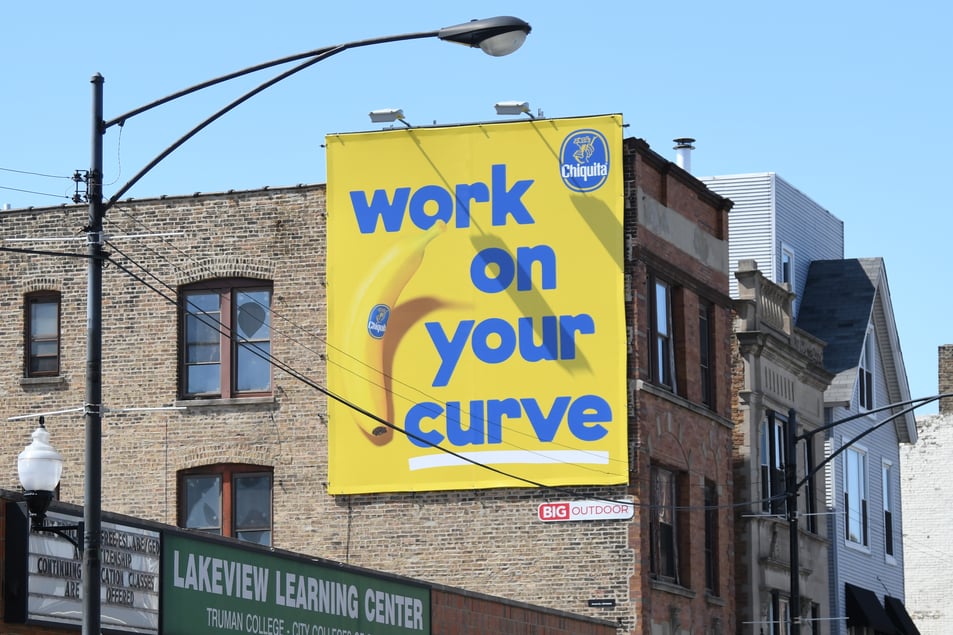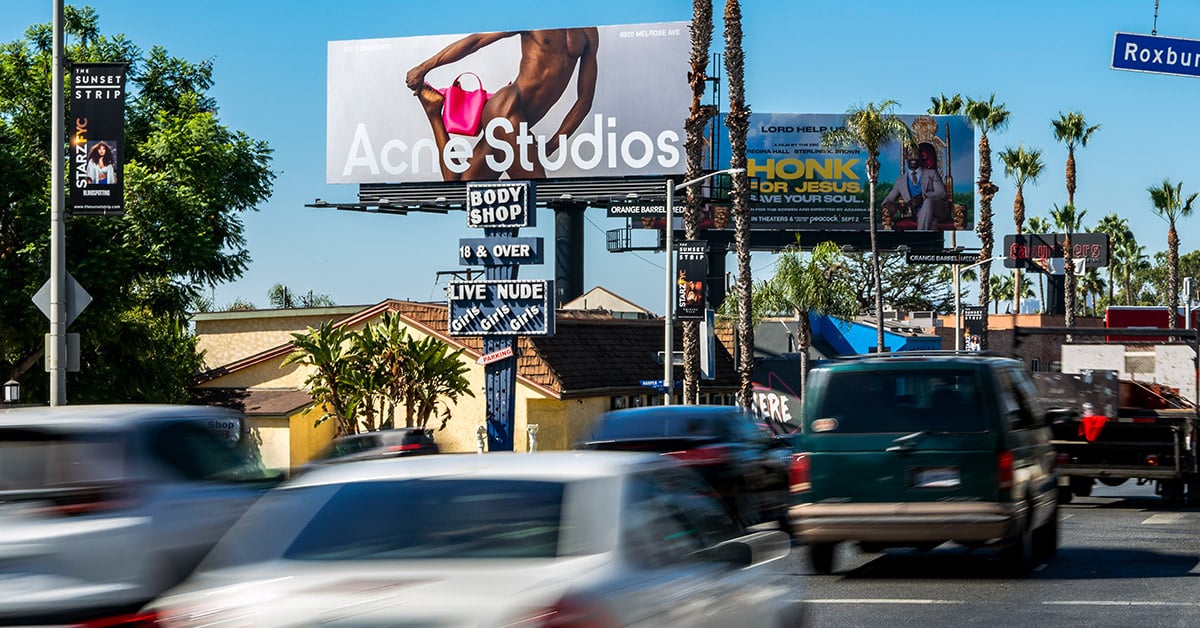Out-of-Home (OOH) rules and regulations can differ significantly from country to country and from municipality to municipality. But a few common constraints govern OOH advertising and where it can be placed.
Many regulations and ordinances control where media owners can secure leases and establish new inventory. Some ordinances dictate how media owners can improve upon existing sites. Media owners often have self-imposed best practices. This helps them follow local politics and landowner requirements.
In short, media owners can’t build what they want wherever they want. Advertisers can’t post what they want wherever they want.
In this article, you’ll learn some of the most common regulations you will encounter as an OOH advertiser. You'll know where you can place your ads, what content ads can contain, and how to set expectations.

1. OOH Content Restrictions
Media owners typically have final approval rights on all content posted. Content restrictions ensure ads are appropriate and follow local cultural norms and values. The limits also allow media owners to remain sensitive to local politics and landowner requirements. Here are some common content regulations to know:
- Offensive or Inappropriate Content: Offensive, obscene, or inappropriate content is often prohibited. This includes material promoting hatred, discrimination, violence, or explicit content.
- False or Misleading Claims: Claims in ads should be evidence-based. False or misleading claims that deceive the audiences are often not allowed. This includes incorrect or unverified health, public safety, and environmental claims (e.g., “100% Recyclable” when it isn’t). If your message could be controversial, prepare evidence supporting your content’s claims.
- Compliance with Advertising Standards: Regulatory bodies establish industry-specific advertising standards. Standards may vary depending on the advertised product or service. For example, some regions have strict alcohol and tobacco regulations. Some areas may prohibit these categories. Some transit authorities require specific language in the ad copy (e.g., “Remember to Drink Responsibly”). Political ads are often required to contain sponsor disclosures.
- Trademark and Copyright Compliance: Content that infringes on the intellectual property rights of others is not allowed, e.g., trademarks, copyrights, and patents. The liability associated with these protections will rest on the advertiser.
- Disrespectful or Harmful Content: Advertisers should avoid content that could be offensive or disrespectful to certain groups or communities. This helps ensure creative approval and avoid posting delays. Advertisers should also refrain from advertising content that may harm children or youths. One example would be vice-related content close to schools.

2. Outdoor Advertising Location Restrictions
There are often guidelines on where outdoor advertising can be placed. These restrictions help preserve specific areas' aesthetic, cultural, and environmental integrity. They protect sensitive areas from visual clutter. Here are some places where outdoor advertising inventory may be limited or prohibited:
- Protected Areas: Certain locations are protected for their natural, historical, or cultural significance. Examples include national parks, heritage sites, historic districts, archaeological sites, and wildlife reserves.
- Residential Zoning: Many municipalities restrict advertising in residential neighborhoods. This is to avoid complaints from private citizens and protect residential property values.
- Cap-and-Replace: Some municipalities will pass cap-and-replace ordinances. These ordinances put a “cap” on the number of assets a media owner can have within a given jurisdiction. Those media owners can only develop new OOH sites if they remove a pre-existing site.
- Moratoriums: Some municipalities have ceased the development of any new OOH assets. They may not even allow the repair or improvement of existing structures. Moratoriums are extreme and designed to phase OOH assets out of an area over time.
- Educational and Religious Institutions: Certain categories cannot advertise near schools and places of worship. Media owners should know their local requirements. They can tell advertisers what inventory is and is not category compliant.
- Transportation Corridors and Scenic Byways: States and local governments often prohibit the development of OOH inventory along new expressways, toll roads, and especially scenic byways (e.g., the Blue Ridge Parkway and certain sections of the Pacific Coast Highway.) This is to ensure driver focus and protect scenic drives and overlooks.
- Proximity to Competing Businesses: It is common practice to prohibit advertisers from posting ads next to competing businesses. Most lease agreements protect businesses from competing advertisements on the property's OOH assets.
- Proximity to Sensitive Facilities: OOH advertising restrictions may exist near hospitals, nursing homes, or military bases. This is to prevent potential disruptions and maintain a respectful environment.
Certain types of OOH formats may need special permitting. For example, Wildposting, Projections, and Sidewalk stenciling may need permits to avoid penalties. Some advertisers engage in guerrilla marketing. This is when an advertisement is placed in a nontraditional space with no permit. Guerilla marketing saves the time and resources required to get the proper permits. But it can also result in fines and immediate ad removal. Advertisers need to understand this about guerilla placements going into their campaign.
3. OOH Size and Placement Regulations
Municipalities may have specific guidelines on the size of outdoor advertisements. They may also have rules about OOH placement near roads, buildings, or other structures. These guidelines govern the physical dimensions, positioning, and installation of OOH advertisements. These ordinances guard against visual clutter, ensure public safety, and maintain aesthetics in popular areas. Media owners are responsible for ensuring their inventory complies with local regulations. But it’s good for advertisers to know limitations that may impact their campaign’s objectives. Here are a few standard size and locations restrictions placed on outdoor advertising:
- Maximum Size: There are often restrictions on the maximum size of outdoor advertisements, including Billboards, Posters, and Digital Displays. The maximum size varies depending on state/county/municipality ordinances and regulations. State regulations are less stringent. But counties and municipalities can pass stricter rules.
- Maximum Allowance for Extensions: Advertisers planning extensions for their OOH should know the size limitations for these embellishments. Extensions are typically limited to no more than 4-5’ above the top of the Billboard, 2’ on the sides, and 1-2’ on the bottom. They cannot exceed more than 20% of the square footage of the Billboard. Not all Billboards can accept extensions. This is due to lease agreements, local ordinances, and the Billboard's structural integrity.
- Minimum Setback Distances: OOH structures must be a minimum distance from roads, sidewalks, buildings, and right-of-ways. This prevents obstruction and ensures public safety.
- Height Restrictions: State and local regulations may specify the maximum height of advertising structures to preserve sightlines.
- Buffer Zones: There may be buffer zones required near sensitive areas. There could be buffer zones for schools, residential areas, or historical sites. This is to limit the impact of advertisements on the surrounding environment.
- Installation Standards: Regulations may specify certain materials and methods for installing outdoor advertisements. Installation regulations are usually in the interest of public and worker safety. For example, adverse weather conditions may delay an advertisement’s installation.
- Digital Display Regulations: There may be restrictions on animation, transition effects, and brightness levels. This is to prevent distractions and maintain driver safety.
- Rotating Advertisements: Some locations may restrict rotating or moving advertisements. This is to minimize visual disturbance and distractions.
Advertisers should know that the above factors can affect their creative executions. These parameters can also inform a lack of advertising opportunities in certain areas.

4. OOH Illumination
Some regulations govern the illumination of static and Digital OOH advertisements. These regulations control outdoor advertising lighting, including brightness, intensity, timing, and duration. They help avoid light pollution and ensure public safety. They also reduce distractions to drivers and pedestrians.
Sometimes there are color and animation restrictions on Digital OOH campaigns. Some areas may restrict advertisements with flashing, blinking, or rapidly changing colors. Similarly, OOH illumination should not interfere with traffic signals and road sign visibility.
Illumination and lighting regulations might affect a campaign’s ability to reach its intended audience. For example, advertisers shouldn’t post a recruiting campaign designed to reach 3rd shift factory workers on inventory that must go dark between Midnight and 6 am.

5. Outdoor Advertising Environmental Impact
Some areas may have regulations to cut OOH's impact advertisements on the environment. Environmental regulations address visual pollution, waste generation, resource consumption, and ecological preservation. Here are common environmental concerns related to outdoor advertising.
- Responsible Material Usage: Some jurisdictions require environmentally-friendly materials for OOH advertising, such as biodegradable or recyclable substrates.
- Avoid Use of Toxic Materials: Advertisers should avoid using materials that contain toxic substances or hazardous chemicals that could harm the environment.
- Use of Sustainable Energy Sources: There’s an increased value placed on using solar-powered formats. More cities are requiring media owners to power their digital networks efficiently.
Environmentally conscious practices show advertisers' commitment to environmental responsibility and sustainability. Collaborate with local environmental authorities and stakeholders. This can help ensure your ads align with ecological protection efforts.
6. OOH Time Constraints
In some areas, outdoor advertisements may have time limits. This can include how long they can display ads and hours of illumination. Time constraints manage the visual impact of advertising, prevent clutter, and ensure regular updates to advertising displays. Here are more details about time limits for outdoor advertising:
- Contract Periods: OOH advertisements often have contract periods with the media owner specifying the start and end date.
- Permit Duration: If a permit is required, the document specifies the timeline. Advertisers must follow this timeline and remove the advertisements after the permit expires. Failure to do so may result in a fine.
- Digital Display Timing: Local ordinances usually control spot durations for digital inventory. Media owners often cap the number of advertisers in a digital loop at 6-8. It’s not uncommon to see spots dedicated to PSAs or on-premise businesses. This is important to know if an advertiser wishes to buy more Share of Voice (SOV) on a given Digital Billboard or Wallscape.
7. OOH Competitive Restrictions
Some locations may place limits on competing ads. They might require a minimum distance for ads from companies that offer similar products or services. These restrictions help prevent market saturation, promote fair competition, and maintain the visual balance of the advertising landscape. Here are more details about possible competitive regulations for outdoor advertising:
- Line of Sight: It’s an industry best practice to set a minimum distance between outdoor advertisements promoting similar products or services from competing businesses. This is often referred to as “line of sight” consideration. It’s not typically guaranteed. The practice prevents the clustering of competing ads and disenchanted advertisers.
- Competitive Separation: Advertisers can request “competitive separation" for digital units. This ensures the spots next to a given advertiser are not running copy from a competing brand.
- Allocation and Required Rotations: In areas of exceptionally high demand and comparatively low supply, media owners often create parameters to ensure the regular availability of their most coveted assets. These are often referred to as “rotary” locations. An advertiser is usually limited to 8-12 weeks, after which they must “rotate” to another area. These contracts often require a minimum commitment to “rotate” into a market’s most coveted spots. This protects the media owner from being “cherry-picked." It also creates opportunities for new advertisers to post on the most premium assets in a market.
8. OOH Removal Obligations
The Media Owner is typically responsible for OOH removal and disposal. Hard takedowns (when a physical ad is removed immediately following a contracted timeframe) are not a given. An advertiser’s copy can “override” indefinitely until another advertiser contracts the occupied space. This override is often welcomed as value-added. But it can be problematic when ads focus on dated events or limited-time offers.
Advertisers must understand that hard takedowns are not typically required by ordinance. They must be requested during the planning process.
Ensure Outdoor Advertising Compliance with Billups
Outdoor advertising regulations can change over time. They also differ from market to market. It’s essential to understand the rules in place. It helps ensure you avoid any penalties or fines and that your ad runs as planned. At Billups, we have a deep and collective knowledge of local markets worldwide. We will help you navigate and follow local laws and regulations to ensure your ad runs smoothly. Contact us today to get started.




